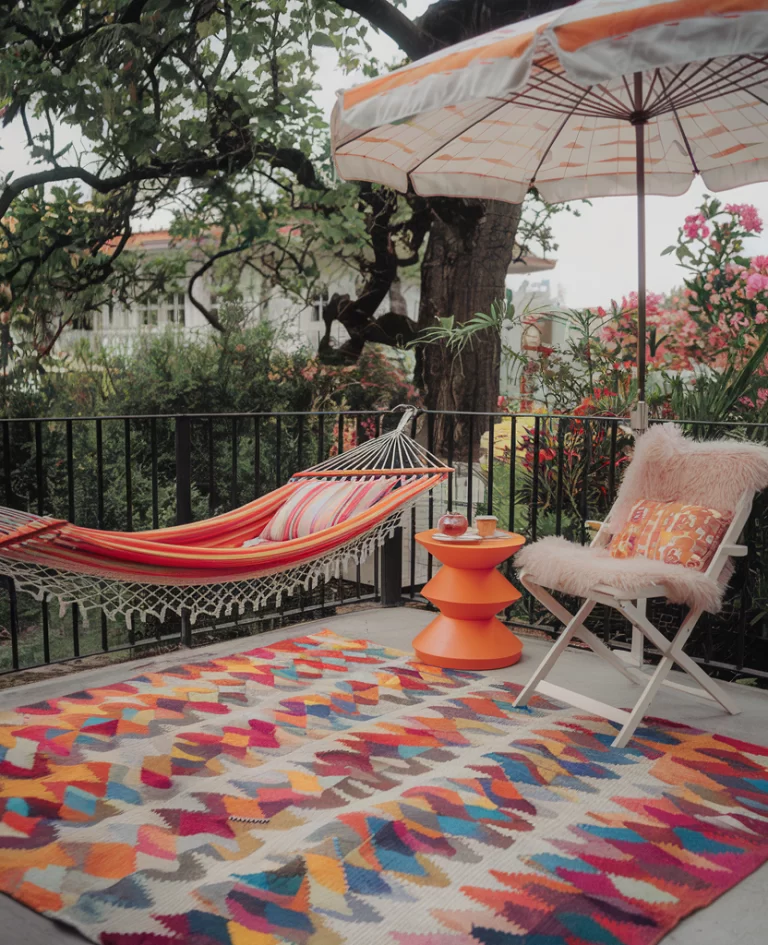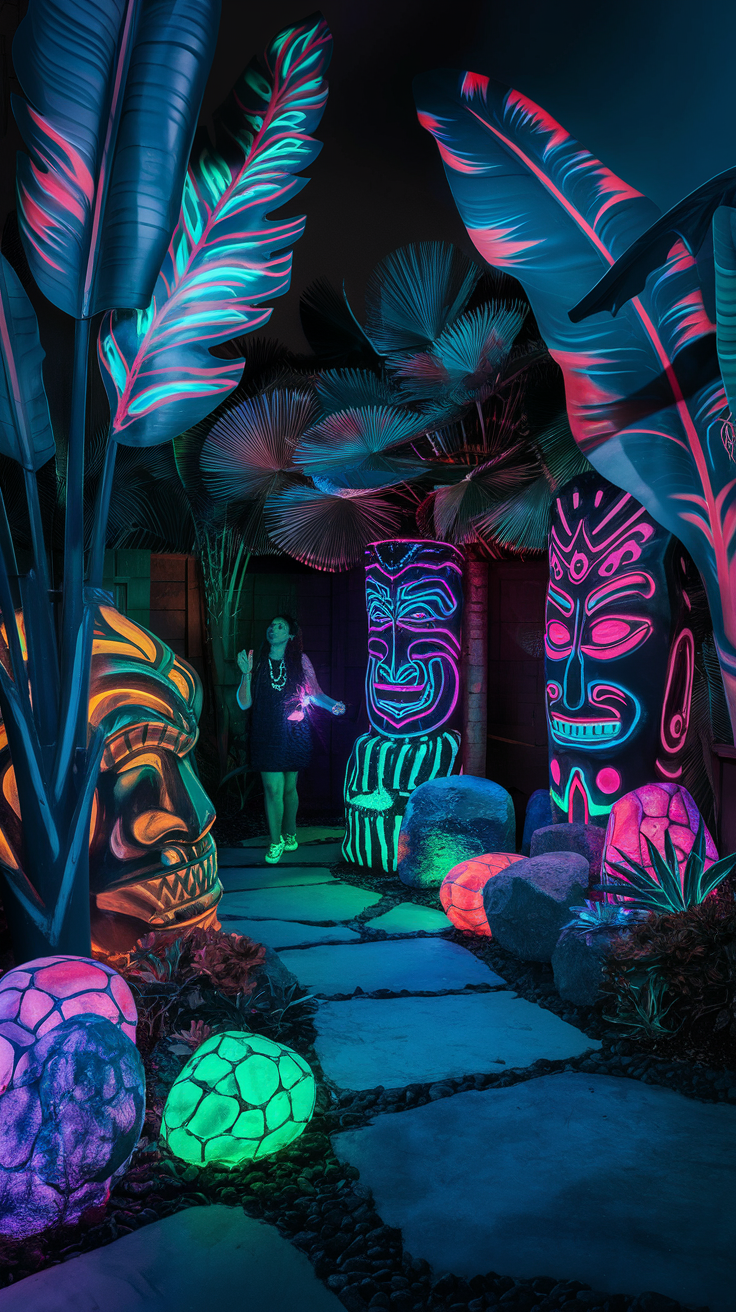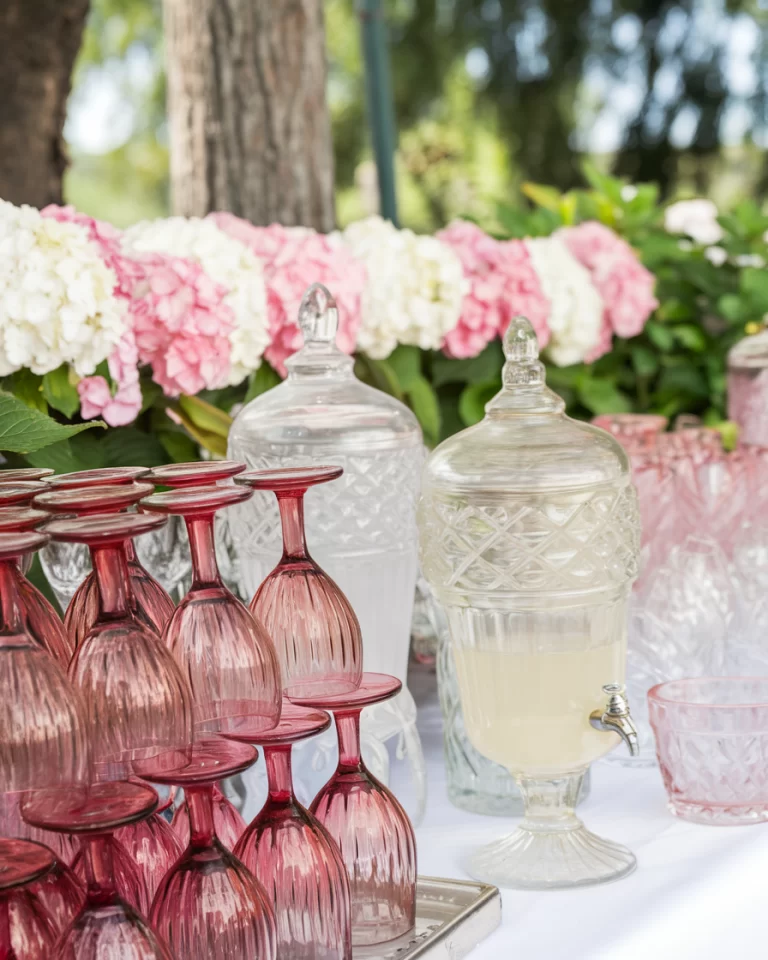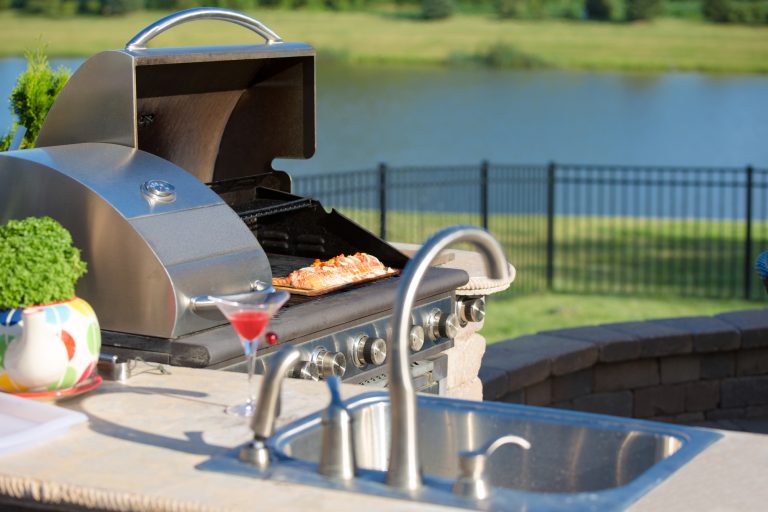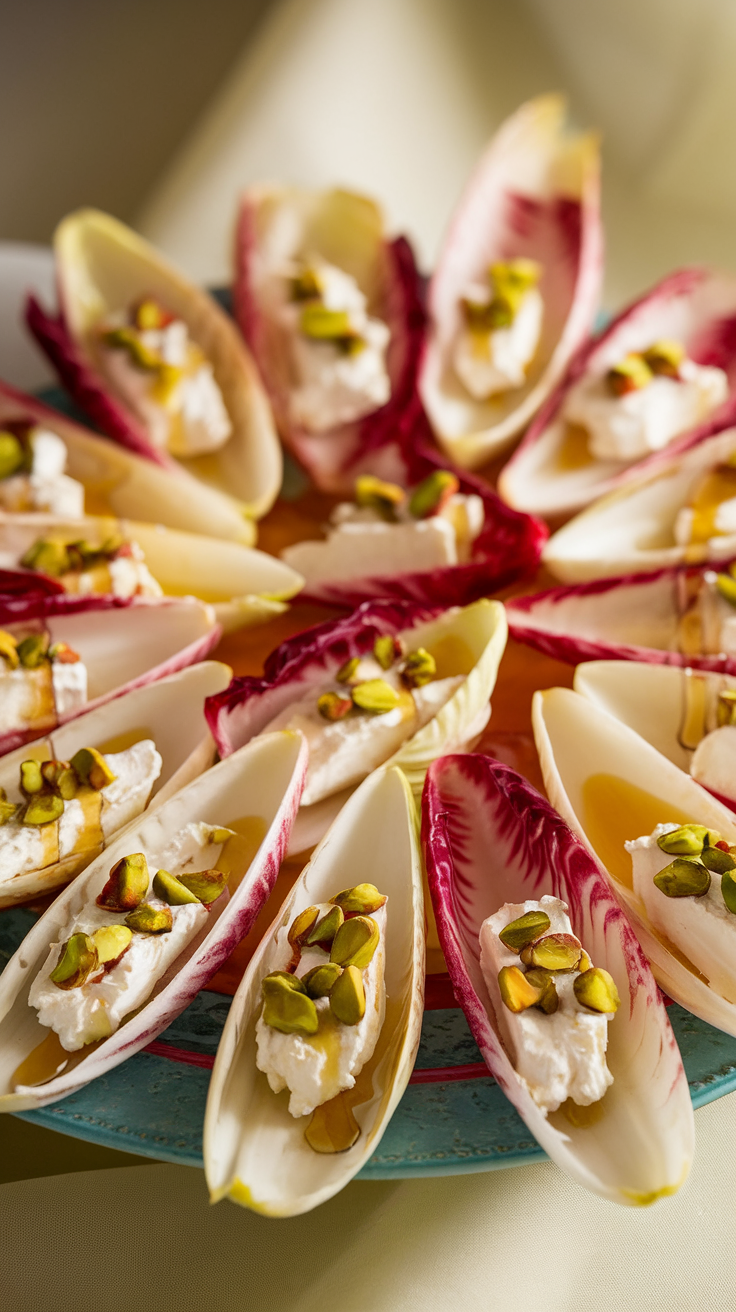Turn 7 Unlikely Materials Into Stunning Patio Wall Decor
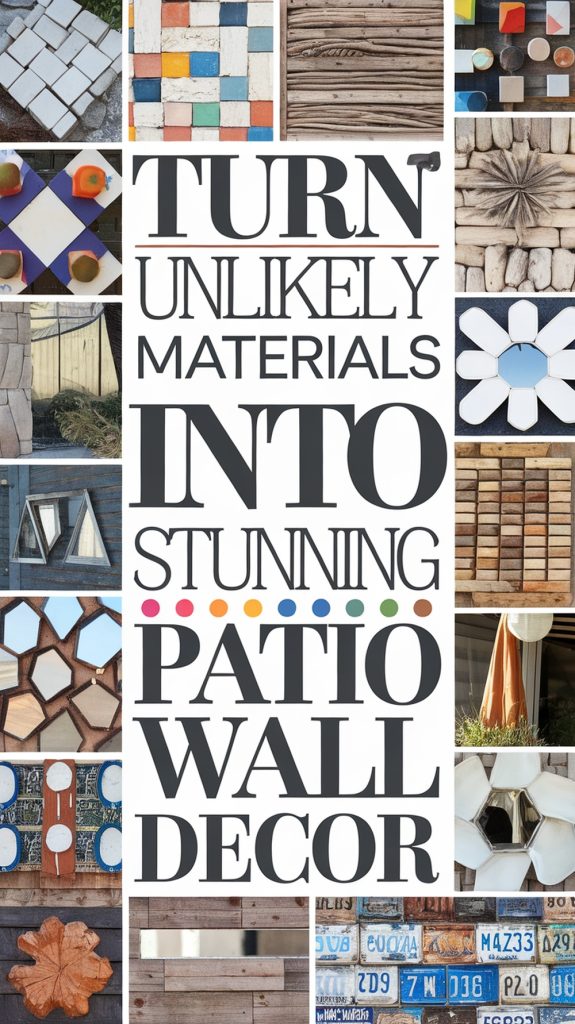
How to Turn 7 Unlikely Materials Into Stunning Patio Wall Decor for Unique Outdoor Spaces
Decorating your patio walls can make the space feel more welcoming and personal. Sometimes, the best ideas use materials you might not think of at first.
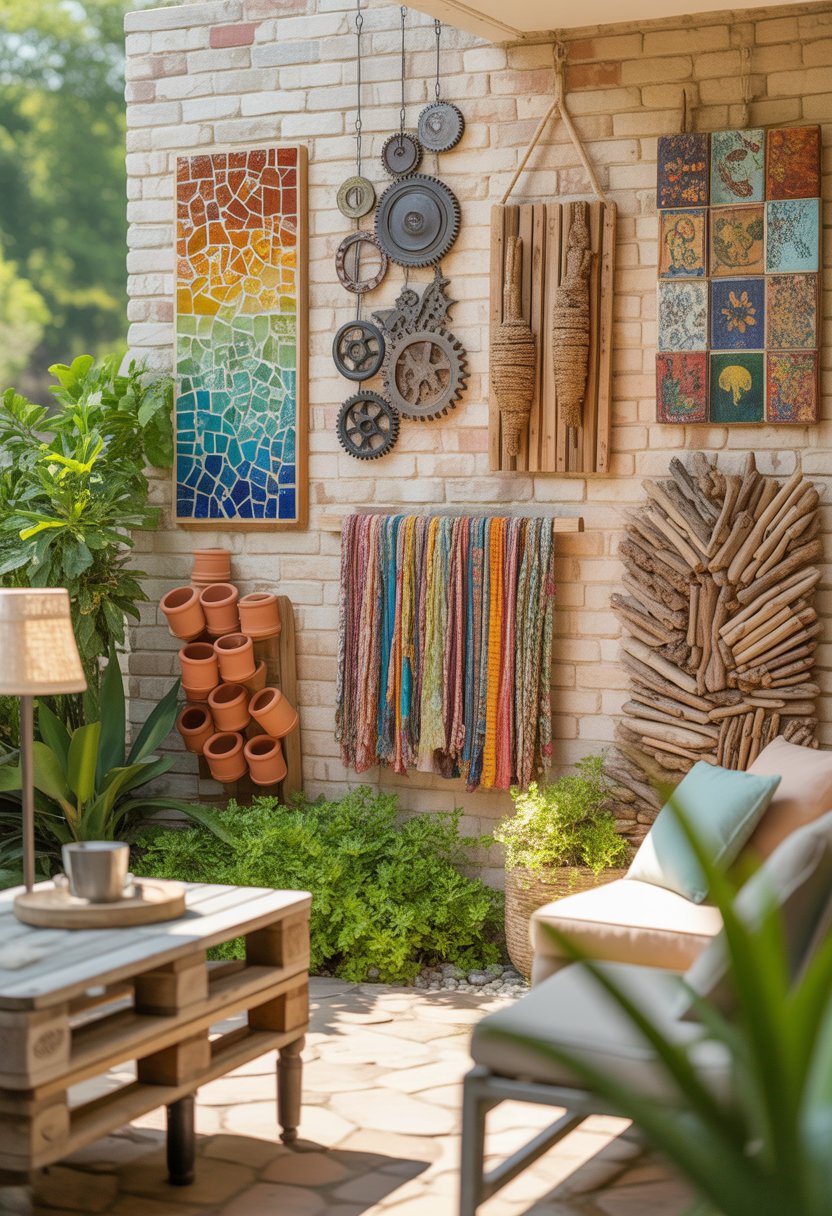
You can create impressive wall decor using items you already have around the house or yard. With a little creativity, your patio walls can become a unique highlight of your outdoor area.
Upcycled Wine Cork Mosaic
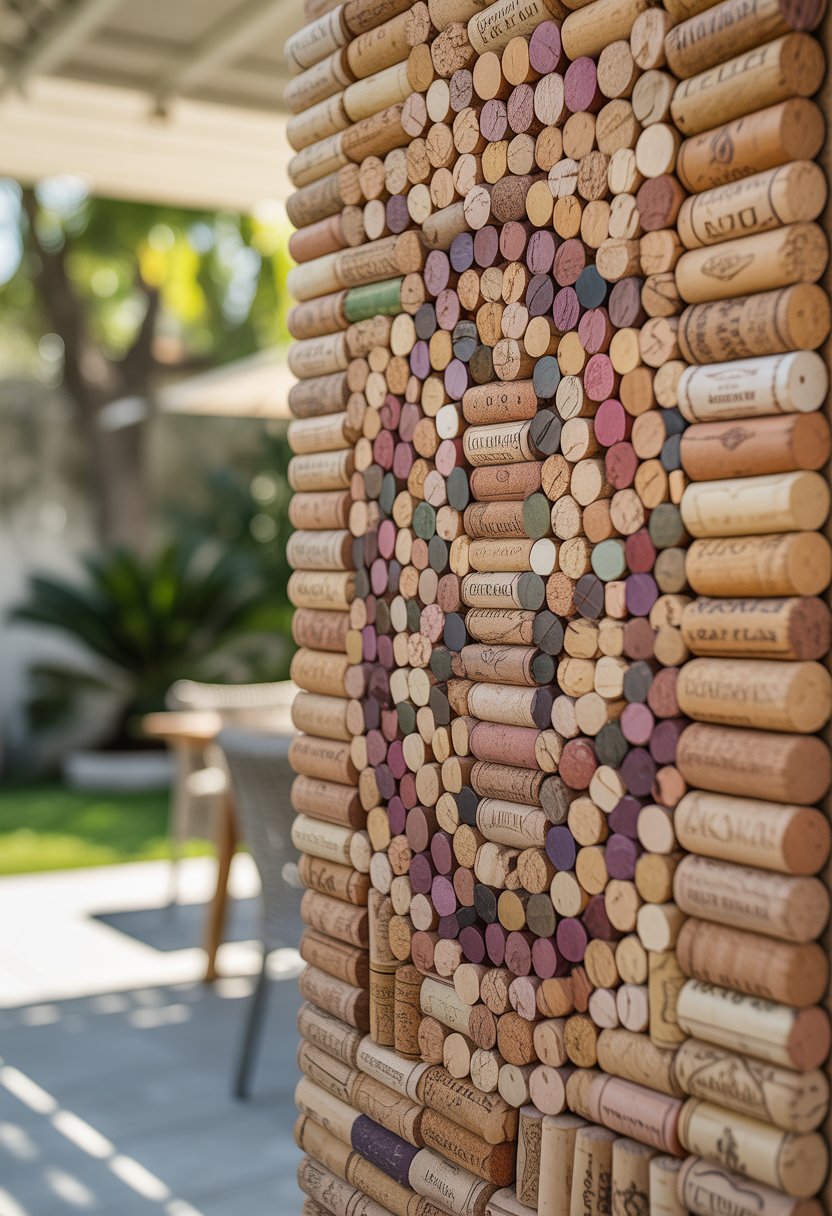
You can use old wine corks to make a creative and textured wall mosaic for your patio. Start by collecting enough corks to cover the area you want to decorate. Clean the corks and let them dry before you start your project.
Lay out your design on a flat surface first. This helps you see how the pieces will fit together. You can cut the corks in half or leave them whole, depending on the look you want.
Glue the corks to a sturdy board or directly to the wall. Use strong craft glue or a hot glue gun for the best results. Press each cork firmly in place to keep them secure.
If you prefer, paint some of the corks for an extra pop of color. You can also mix in other items, like small stones or bottle caps, between the corks if you want more variety. Let everything dry before hanging up your mosaic.
Driftwood Frame Art

Driftwood is often found along riverbanks, lakes, or beaches. It has a unique look that fits well with outdoor spaces. You can use pieces of driftwood to create frames for patio wall art.
Look for pieces that are straight or have interesting shapes. Rinse off any dirt and let the wood dry completely before you start. You can leave the wood natural or give it a light sanding if you want a smoother texture.
Lay out the driftwood pieces in a square or rectangle. Use wood glue or small nails to connect the corners. For a simple design, add a photo or print and attach it to the back.
You can also string small shells, pebbles, or feathers inside the frame. Hang the finished frame with sturdy hooks or strong wall adhesive. Driftwood art adds a natural and relaxed detail to your patio walls.
Repurposed License Plate Sculpture
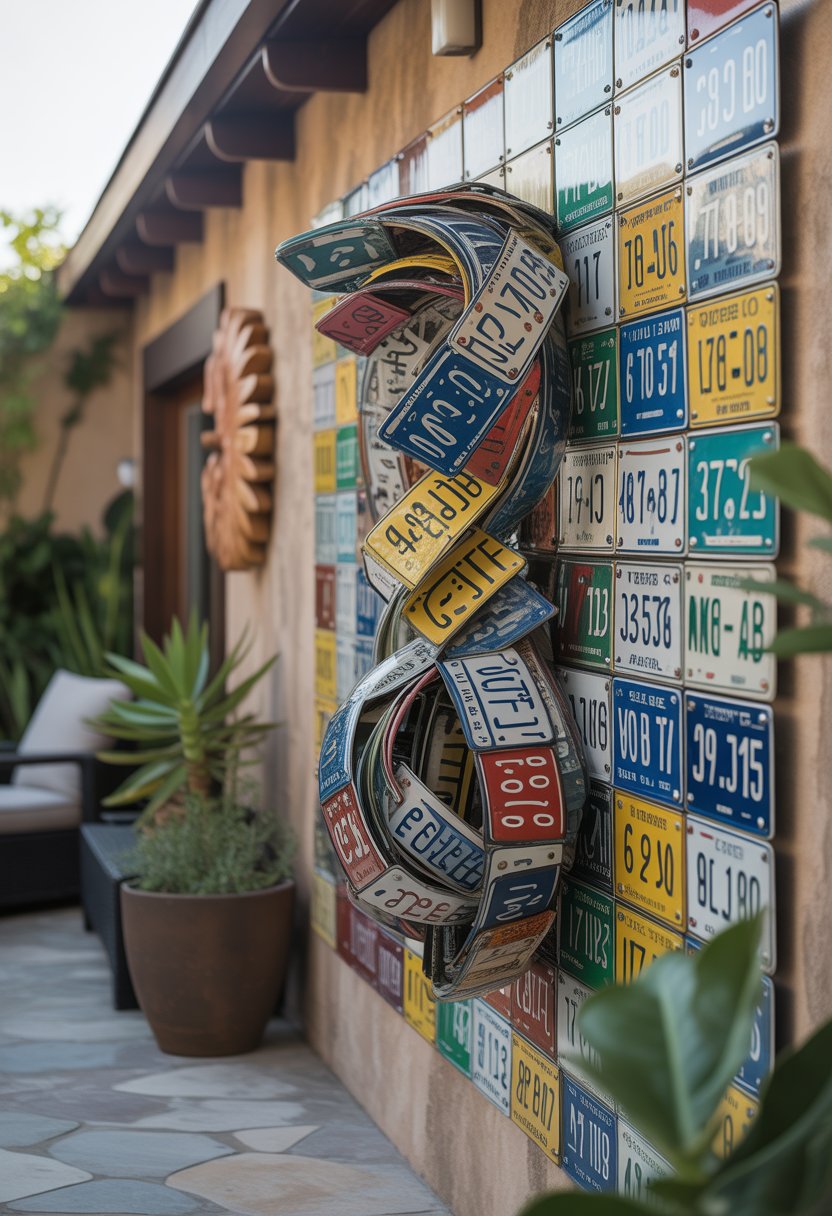
Old license plates can become a creative and eye-catching feature on your patio wall. Their colors and numbers add instant character. You can collect plates from different places or use ones with special meaning.
Cut or bend the plates into shapes like leaves, fish, or geometric patterns. Use tin snips or metal shears for smooth, safe edges. Lay out your design on the ground first to see how the pieces fit together.
Attach the plates to a wooden board or directly to your wall with screws or strong adhesive. Make sure to space them evenly or overlap for a layered look. If the plates are rusty, consider sealing them with clear spray to prevent further weathering.
A license plate sculpture works well as a focal point or background. It can also be moved easily when you want to update your patio decor. This type of wall art is sturdy and requires little upkeep, making it practical for outdoor use.
Painted Pallet Wood Panels
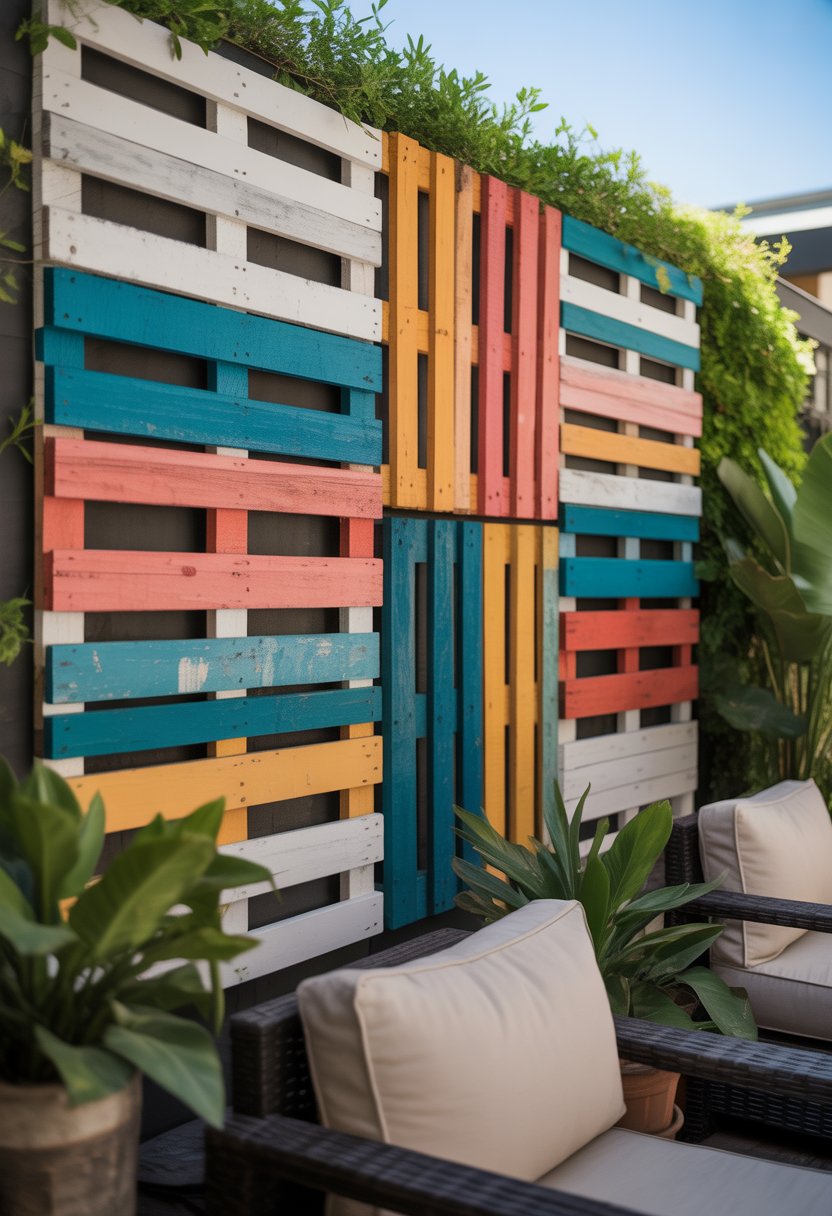
You can use old pallet wood to make creative wall decor for your patio. Pallets are easy to find and often free from garden centers or stores. Clean the wood and sand the rough edges so you have a safe surface to work with.
Arrange the pallet boards to fit the space on your patio wall. Nail or screw the boards together to form a sturdy panel. You can use just one pallet or combine a few, depending on your wall size.
Choose exterior paint in your favorite colors. Painting each panel a solid color works well, or you can try stripes or simple patterns. Use stencils if you want shapes, words, or basic images.
Hang your finished panel on the patio wall. Make sure to use suitable hooks or anchors for safety. Painted pallet panels add color and texture without costing a lot of money.
Broken Tile Mosaic
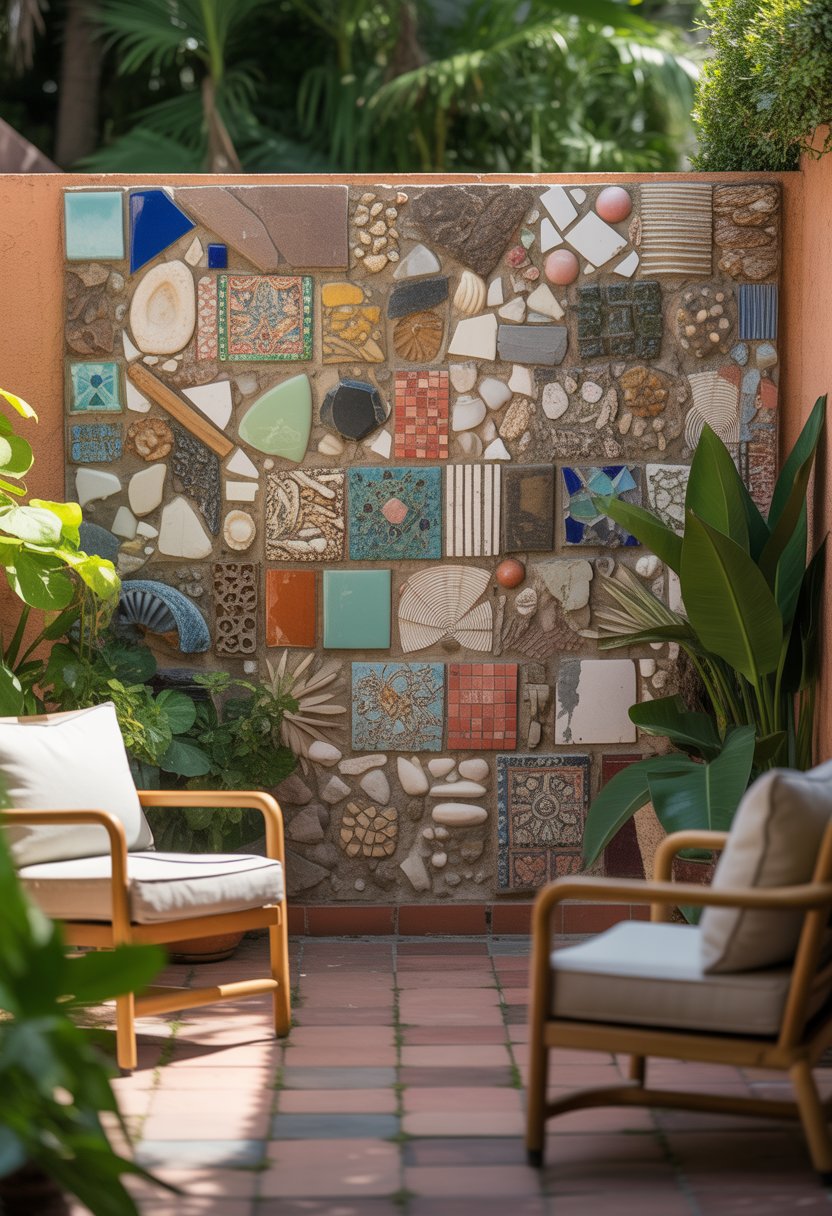
You can use broken tiles to make eye-catching wall art for your patio. Collect old tiles in different colors and shapes. Clean the pieces and lay them out on a flat surface to plan your design.
Use construction adhesive or tile glue to stick the pieces onto a sturdy board or directly onto your patio wall. Press each tile piece firmly in place, leaving small gaps between them.
Once the glue dries, apply grout over the tiles, filling the gaps. Wipe away any excess grout with a damp sponge before it dries. Let everything set for at least a day.
A tile mosaic makes a unique accent that adds color and texture to your outdoor space. It is also a good way to reuse materials you already have.
You can create patterns, shapes, or even simple pictures, depending on the tiles you have. Try to pick grout and tile colors that match your patio style. If you want, you can seal your finished mosaic to help protect it from rain or sun.
Old Window Frame Garden Mirror
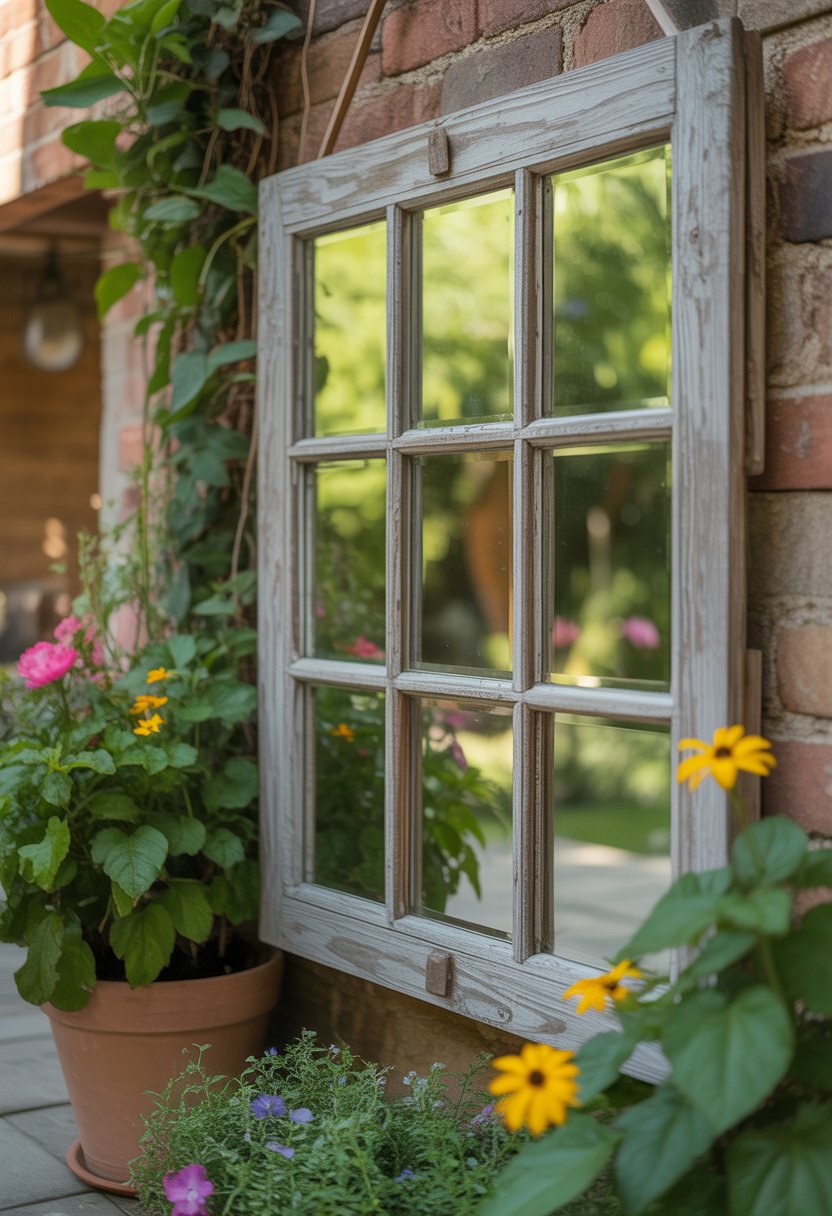
You can recycle an old window frame to make a unique patio wall mirror. Look for a frame with all the glass panes still in place. Clean the frame well and remove any flaking paint.
To turn it into a mirror, buy mirror-effect spray paint or thin mirror tiles at a hardware store. Apply the mirror spray to the glass panes or glue mirror tiles to them. Let everything dry before you hang up the frame.
Mount the finished mirror on your patio wall using strong hooks or brackets. This mirror can help make your patio look bigger by reflecting plants and sunlight. Using an old window frame gives your patio character and keeps old materials out of the landfill.
Rusty Metal Sheet Stencils
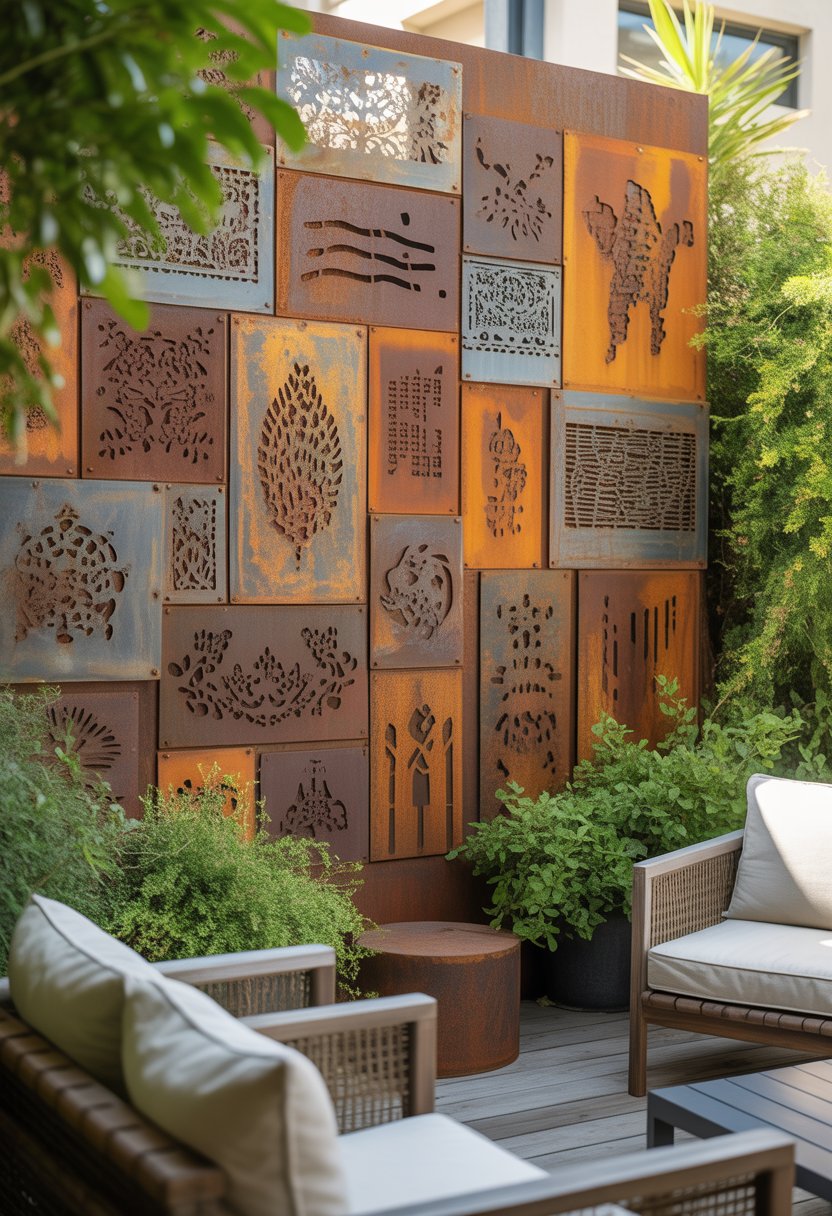
You can use old, rusty metal sheets to make unique outdoor wall art. Their natural patterns and colors add a vintage or industrial touch to your patio.
Cut the metal sheets into simple shapes like circles, leaves, or geometric designs. Be sure to use gloves and tools made for cutting metal to keep yourself safe.
Once you have your shapes, attach them to your patio wall with strong hooks or screws. Leaving some space behind the shapes lets light make interesting shadows on the wall.
If you want to highlight certain spots, spray paint over the rusty metal with a stencil. This adds another layer of design without covering the weathered look.
Combining plain rusty pieces with some stenciled designs can give you a balanced and eye-catching display. You can also try arranging several smaller pieces together for a gallery effect.
Vintage Bicycle Wheel Wall Clock
You can turn an old bicycle wheel into a creative wall clock for your patio. Start by cleaning the wheel and removing any rust. A coat of paint can help match the wheel to your outdoor style.
Attach large numbers to different spokes to mark the hours. You can use wooden numbers, metal ones, or even paint them on. Find a simple clock mechanism at a craft store and fix it to the center of the wheel.
Hang the wheel on your patio wall using strong hooks or anchors. Make sure the clock hands can move freely and are easy to see from a distance. This unique piece can add a vintage feel and keep you on time while outside.
Try adding small decorations like faux flowers or ribbons for an extra personal touch. Use weather-resistant materials so your clock holds up outdoors. This project lets you give new life to something old and unused.
CD Disc Reflective Art
Old CDs can be reused to make shiny, eye-catching wall art for your patio. You only need CDs, glue, and a surface to stick them on, like a piece of wood or an outdoor wall.
Arrange the CDs in any pattern you like—circle, wave, or even a mosaic design. The discs reflect sunlight, creating interesting light effects during the day.
Use strong outdoor glue to attach the CDs. Make sure the surface is clean and dry before gluing so the discs stick well.
If you want to add more color, paint the CDs before gluing them down. You can also cut the CDs into pieces for a different look. Wear gloves if you decide to cut them, as the edges can be sharp.
Hang your finished art where it will catch the light. It can brighten up a dull area and add some sparkle to your patio space.
Concrete Block Planter Wall
You can use plain concrete blocks as a base for a patio wall planter. Stack the blocks in a staggered pattern for extra stability. Turn some of the blocks with the opening facing out to create built-in planter boxes.
Fill the block openings with soil and add succulents, herbs, or small flowers. Concrete blocks hold up well outdoors, and their neutral gray color fits many patios.
If you want more color, paint the blocks with weatherproof paint before stacking them. You can also use blocks of different sizes to create a more interesting look.
This type of wall is sturdy and easy to rearrange if you want to change your patio layout. Water your plants as usual and check that there is good drainage.
Important Safety And Preparation Tips
Some materials can have sharp edges, chemicals, or risks you might not expect. Prepping your patio wall and protecting your work from moisture or UV rays helps your decor last longer.
Handling Unconventional Materials Safely
When dealing with things like metal scraps, broken tiles, or repurposed wood, always check for rough edges, splinters, or rust. Wear gloves and eye protection when cutting, sanding, or drilling. Loose particles from glass or ceramic pieces can cause injury.
If you use paints, glues, or sealants, pick ones labeled non-toxic and made for outdoor use. Work in a well-ventilated area, especially if using sprays, solvents, or epoxy. Never use materials from unknown sources, especially if they seem dirty or have odd smells, as they could carry mold or pests.
Keep tools organized and unplug power tools when not in use. If you work with children or pets around, make sure sharp or dangerous items are out of reach. Cleaning up right away reduces the chance of injury or accidents.
Surface Preparation And Weatherproofing
Start by wiping down your patio wall with warm, soapy water to remove dirt and dust. Let the wall dry completely before you begin. If the surface is rough, sand it lightly for better grip.
Checklist for surface prep:
- Remove old paint or flakes
- Fill in cracks or holes
- Allow the surface to dry
You should use a primer if you’re attaching materials that need to stick well, such as tile or heavy decorations. For painted elements, pick paints rated for outdoor use. Seal porous materials like wood, fabric, or clay with a clear outdoor sealant. Metal decor should be treated with a rust-resistant coating.
Pay attention to moisture. If you live in a rainy area, use waterproof adhesives and check the placement so water can drain away. UV protectant sprays help prevent fading and damage from sun exposure.
Design Principles For Patio Wall Decor
Choosing the right materials for patio wall decor involves more than style. Focus on how colors, textures, and materials impact your outdoor space and the environment.
Balancing Texture And Color
Patio wall decor stands out when you combine different textures and colors. For example, use rough stone tiles with smooth glass or metal for contrast. Pairing natural wood planks with bright ceramic plates creates a simple but interesting look.
When picking colors, try to match—or purposefully contrast—the colors in your garden and patio furniture. Soft, earthy tones (like beige and olive) blend well with plants, while bold colors (such as red or blue) draw attention. A good rule is to use no more than three main colors to avoid a messy look.
Texture can also affect how light and shadow play on your wall. Matte surfaces absorb light, while shiny or gloss textures reflect it. Mixing both types can add depth without needing more decor.
| Texture Type | Effect | Example Material |
|---|---|---|
| Rough | Adds rustic vibe | Burlap, brick |
| Smooth | Clean, modern finish | Glass, metal |
| Patterned | Fun and lively | Painted tiles |
Sustainable And Eco-Friendly Approaches
Sustainable decor uses materials that are recycled, upcycled, or eco-friendly. Repurpose old doors, reclaimed wood, or even metal scraps as wall art. These choices help the environment by reducing waste and saving resources.
Using living walls—like mounted planters or vertical gardens—adds greenery and cleans the air around your patio. Bamboo and cork are other options that grow quickly and are renewable.
Look for non-toxic paints and stains if you plan to color any materials. Use screws and fasteners made from recycled metals when possible. If you use plastic, choose recycled plastics labeled “post-consumer” to minimize new plastic production.
You can create interesting looks by combining reclaimed materials with natural plants. This not only shows your style but also keeps your wall decor eco-conscious.

